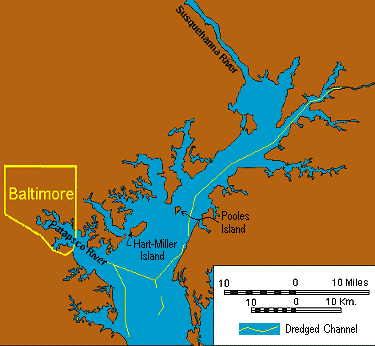Dredged Sediment Studies
| contact: Stephen Van Ryswick ([email protected]) |
 The Port of Baltimore is a major component of the economic and transportation infrastructure of the State of Maryland. More than 2,000 vessels move through the Port of Baltimore each year carrying 40 million tons of cargo. The Port's activities contribute some $1.4 billion in business to Maryland's economy every year and provide jobs directly to more than 18,000 people. Maritime related jobs in the state number more than 125,000. Located in the northern part of the Chesapeake Bay, the Port is accessed by over 120 miles of channels, which provide connections to the main part of the Chesapeake Bay to the south, and to the Chesapeake and Delaware (C&D) Canal to the north. These navigational channels are located in and adjacent to the Chesapeake Bay turbidity maximum zone, and both the channels and the surrounding areas accumulate sediments composed primarily of fine grained clayey silts and silty clays. More information about the Port of Baltimore is available at:
The Port of Baltimore is a major component of the economic and transportation infrastructure of the State of Maryland. More than 2,000 vessels move through the Port of Baltimore each year carrying 40 million tons of cargo. The Port's activities contribute some $1.4 billion in business to Maryland's economy every year and provide jobs directly to more than 18,000 people. Maritime related jobs in the state number more than 125,000. Located in the northern part of the Chesapeake Bay, the Port is accessed by over 120 miles of channels, which provide connections to the main part of the Chesapeake Bay to the south, and to the Chesapeake and Delaware (C&D) Canal to the north. These navigational channels are located in and adjacent to the Chesapeake Bay turbidity maximum zone, and both the channels and the surrounding areas accumulate sediments composed primarily of fine grained clayey silts and silty clays. More information about the Port of Baltimore is available at:
https://mpa.maryland.gov/pages/default.aspx
Maintenance dredging of the channels is an ongoing process necessary to ensure navigational access to the Port. In the past some of the dredged sediments were placed within designated open-water sites adjacent to Pooles Island in the northern Chesapeake Bay, while the remainder were placed in confined sites such as Hart-Miller Island and Cox Creek. Open-water placement ceased at the end of 2010, and placement in Hart-Miller Island ceased in 2009. Studies were conducted annually since 1980 by the Maryland Geological Survey on the dredged sediments placed at the designated open-water sites. The studies include: 1) stratigraphic and sedimentological analyses to examine the placement of sediment and its consolidation history; and 2) process studies to estimate the dispersion of the discharged sediments in the water column, the mass movement of fluidized deposits, and the resuspension and erosion of sediments from the deposits. More detail on these studies is available on the “Select Past Projects” page. Annual studies on the trace metal chemistry in bottom sediments around Hart-Miller Island were also conducted and provided to the Maryland Department of the Environment.
Currently, the sediments dredged from the channels are placed at the Poplar Island restoration site, Cox Creek Dredged Material Containment Facility and the Masonville Placement Site. More information on these sites and other aspects of the Port’s Dredged Material Management Program (DMMP) is available at: http://www.marylandports.com/greenport/Pages/dmmp.aspx
The Maryland Geological Survey continues to provide scientifically sound data to the Port by conducting annual bottom sediment trace metal studies around Hart-Miller Island and Poplar Island, and by providing information on the geology, substrate and groundwater conditions at potential future dredged sediment placement sites and those used in the past.


